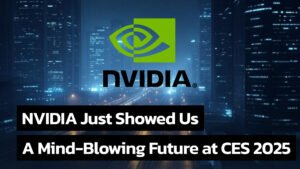In a monumental move that’s set to redefine the global AI landscape, chipmaker NVIDIA is gearing up to manufacture up to $500 billion worth of
NVIDIA AI supercomputers — all within the United States over the next four years.
This massive initiative marks a historic milestone for the world of artificial intelligence, finance, and tech infrastructure, setting the tone for what’s expected to be a revolutionary year for AI in 2025 and beyond.
💡 What Makes This Development So Powerful?
For the first time ever, NVIDIA’s entire AI infrastructure — from chip design to final assembly — will be produced domestically in the USA.
NVIDIA’s visionary founder and CEO, Jensen Huang, explained:
“The engines of the world’s AI infrastructure are being built in the United States for the first time. Adding American manufacturing helps us better meet the incredible and growing demand for AI chips and supercomputers, strengthens our supply chain, and boosts our resiliency.”
This decision doesn’t just impact the technology sector — it carries deep financial, political, and employment implications for the country.
🏭 A Deep Dive into worth $500 billion NVIDIA AI Supercomputers Plan
With key manufacturing alliances involving TSMC, Foxconn, Wistron, Amkor Technology, and Siliconware Precision Industries (SPIL), NVIDIA has commissioned over 1 million square feet of advanced production space across the United States.
Let’s break down where the magic will happen:
Phoenix, Arizona – TSMC has already started producing the cutting-edge Blackwell AI chips.
Houston & Dallas, Texas – Supercomputer assembly plants led by Foxconn and Wistron are currently under development, with mass production set to begin between April and June 2025.
Arizona (again) – Amkor and SPIL are preparing to handle chip packaging and testing, a key step in ensuring AI chip durability and performance.
📈 Economic Impact & Financial Forecast: Why This Move Matters
NVIDIA’s US-based AI production ecosystem is projected to:
Inject billions into the US economy over the next decade.
Create hundreds of thousands of high-tech jobs in states like Arizona and Texas.
Build a resilient domestic AI infrastructure that reduces reliance on foreign manufacturing.
From an investment and finance perspective, this could have ripple effects across:
The NASDAQ tech sector 📊
Semiconductor ETFs and AI stock portfolios 💼
Venture capital activity in AI startups, especially those integrating NVIDIA hardware 🔍

🤖 Inside the Future: AI Factories & Digital Twins
NVIDIA isn’t just building supercomputers — it’s building the future of intelligent infrastructure.
Its Omniverse platform and Isaac GR00T robotics system will be deployed to:
Create digital twins of manufacturing facilities.
Automate operations using robotic precision.
Ensure unprecedented speed and accuracy in AI system production.
These futuristic “AI factories” — or gigawatt-scale data centers — are engineered specifically to handle massive AI workloads, such as:
Large language models (LLMs)
Robotics training
Climate modeling
Advanced healthcare AI diagnostics
Experts predict that by late 2025 or early 2026, we could see dozens of such mega facilities powering everything from autonomous vehicles to virtual reality education platforms.
📅 Looking Ahead: What Could Happen by the End of 2025 and Into 2026?
Let’s fast-forward to the end of 2025 and the beginning of 2026:
Increased stock valuation of NVIDIA and its partner companies could trigger a tech bull run.
AI-driven manufacturing models may become the new standard, replacing traditional processes.
The US could emerge as the undisputed global leader in AI infrastructure, challenging even China’s dominance in hardware production.
Startups like Lepton AI (which NVIDIA is rumored to acquire) might become crucial to offering AI-as-a-Service, renting powerful AI compute via the cloud.
This shift will also influence global finance, reshaping how hedge funds, tech investors, and governments allocate resources toward AI and semiconductors.




































